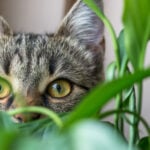Some of the links in this post may be affiliate links.
If you have cats and dogs at home, it is a very valid concern to be worried about the toxicity of your houseplants. This post is by no means a comprehensive list of nontoxic houseplants, but it contains a selection of some of the most widely grown houseplants, and a handful of some more unusual ones that you may wish to try growing!

All of the houseplants I used on this list are verified to be nontoxic by the ASPCA. That being said, please note that any plants that are ingested by your cats or dogs can still cause vomiting or upset your pet’s stomach.
However, plants that are listed as nontoxic are not expected to be life threatening.
If you are ever in doubt, be sure to verify on the ASPCA website, or call your veterinarian. (There are many sources out there with incorrect information so use reputable sources.)
Table of Contents
BEST NONTOXIC HOUSEPLANTS FOR CATS AND DOGS
Here are some wonderful choices for pet-safe houseplants.
1. AFRICAN VIOLET (Saintpaulia spp.)
African violets are not just plants that grandma used to grow. There are a lot of beautiful African Violets and they are a joy to grow. If you like variegated plants, there are even variegated varieties that you can enjoy!

A happy African Violet can be kept in almost constant bloom!
2. ALUMINUM PLANT (Pilea cadierei)
It’s easy to see how the plant gets its name, with its beautiful silver markings on the foliage. This plant is easy to grow, and should be more popular than it is!
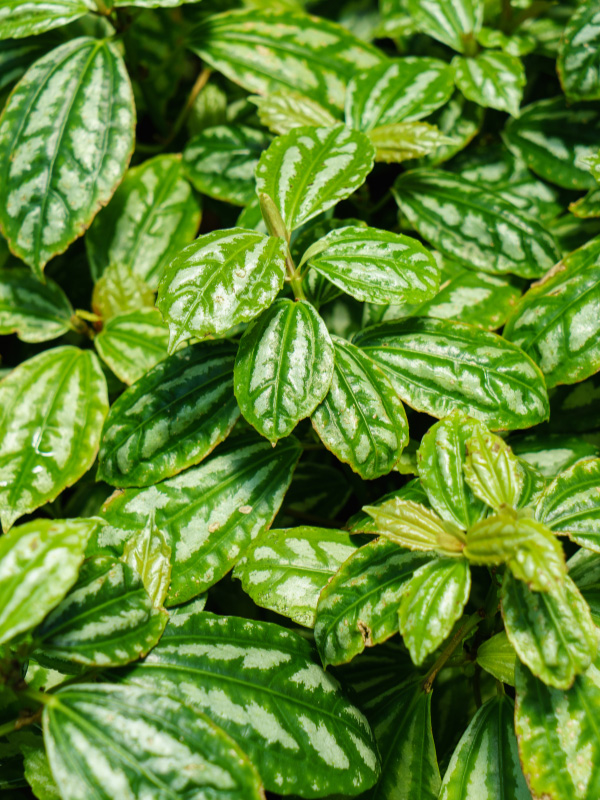
3. SPIDER PLANT (Chlorophytum comosum)
Who doesn’t love a well grown spider plant? Cats in particular love to play with these…but rest assured that they are considered non-toxic.

3. ARECA PALM (Dypsis lutescens)
If you’re looking for a larger palm for your home, the Areca Palm is a great option. It is safe for pets, but they can be prone to spider mites indoors so be sure to increase humidity to help deter them.
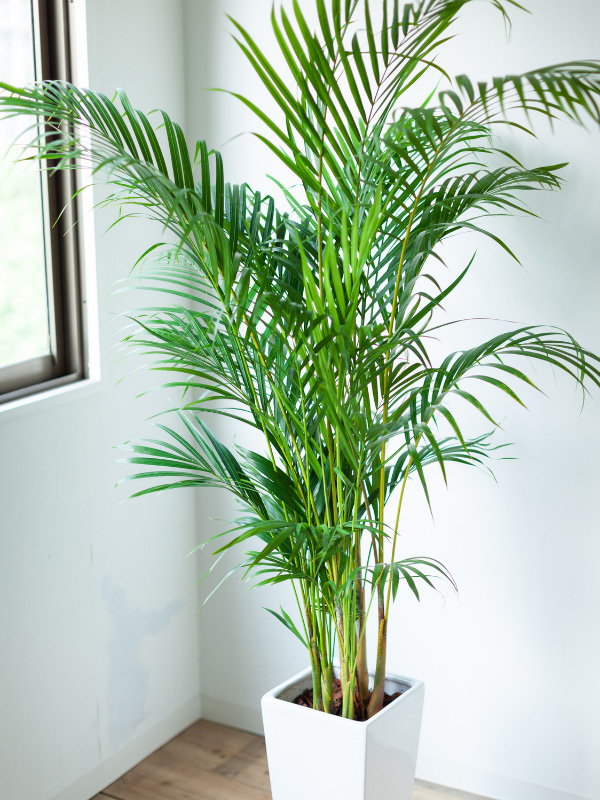
5. NORFOLK ISLAND PINE (Araucaria heterophylla)
Norfolk Island Pines are actually very large trees in their native environment. Although they are fairly slow growing, they can make quite a statement piece over time!

6. BABY RUBBER PLANT (Peperomia obtusifolia)
There are many beautiful Peperomia species to grow, and the “baby rubber plant” tops them all as being easy to grow and very drought tolerant. There is a plain green version of this plant, as well as a variegated version shown below.

7. Rabbit’s Foot Fern (Davallia spp.)
The Rabbit’s Foot Fern gets its name from furry rhizomes that will creep all over the surface of your pot, and even down the sides.
This is an easier fern to keep in good shape indoors, as long as you don’t let it dry out too much.

8. Parlor Palm (Chamaedorea elegans)
The Parlor Palm is a delightful indoor palm, and a great one if you don’t have much room. It is a smaller palm and perfect for smaller spaces.
Like any palm, never let them dry out completely, and
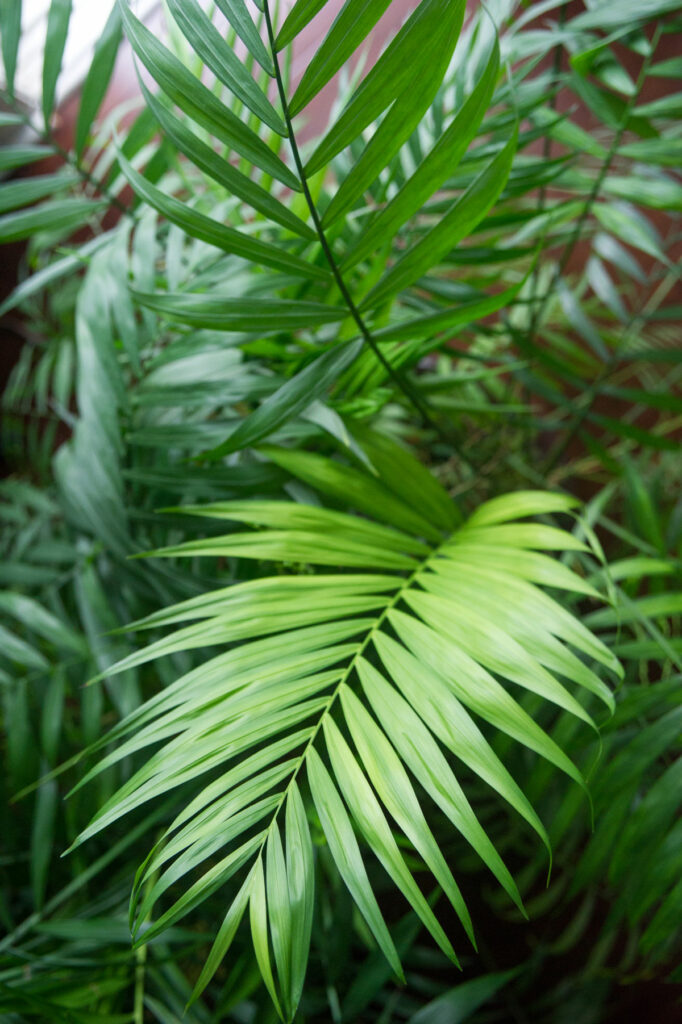
9. BOSTON FERN (Nephrolepis exaltata)
So many people struggle with ferns, but the key is to give them plenty of moisture and never allow them to dry out. Be sure not to miss my fern care post for more details, and if you’re a fern lover, check out my post on 21 gorgeous fern varieties to add to your collection.
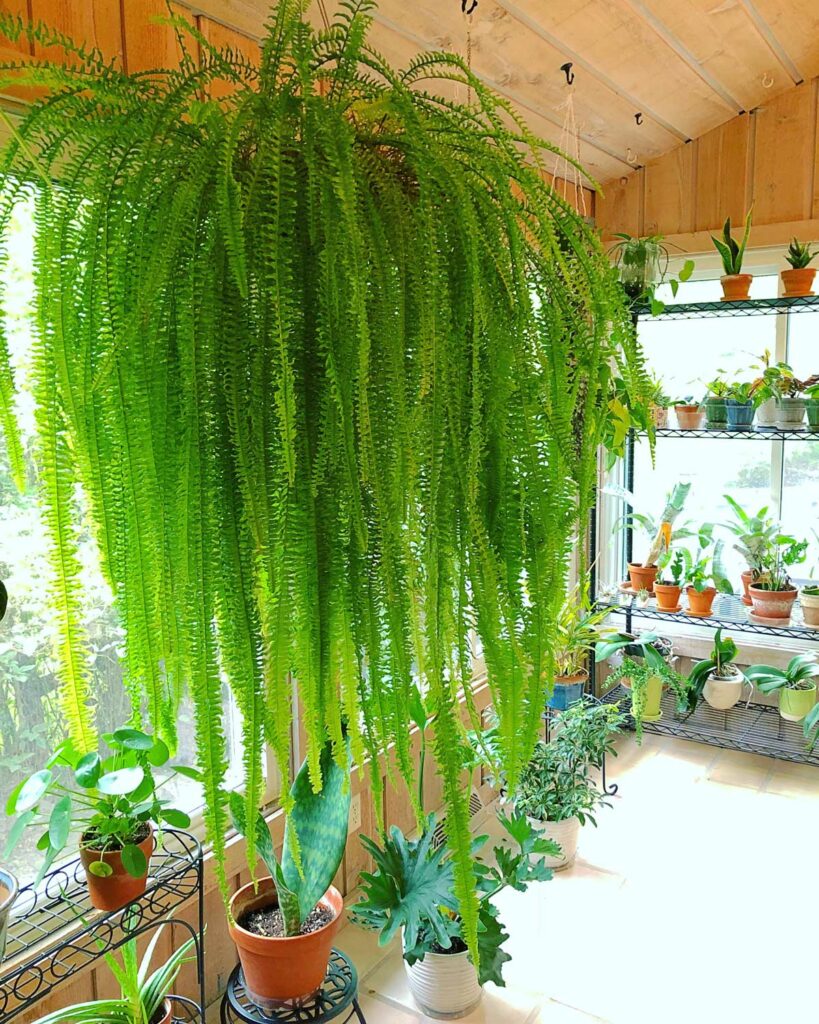
10. PONYTAIL PALM (Beaucarnea recurvata)
Despite its common name, the Ponytail Palm is not a palm at all. Treat it more like a succulent. With plenty of light and appropriate attention to soil moisture, it very easy to care for.

11. BURRO’S TAIL (Sedum morganianum)
This beautiful trailing succulent is easy to grow if you have enough light. The plump leaves are fragile though and can fall off easily, so be careful handling it!

12. CALATHEA spp.
The notoriously finicky Calathea! Many of these plants have been reclassified from the Calathea genus and into the Goeppertia genus.
Be sure not to miss my posts on caring for Calathea, and another post with the dozens of Calathea varieties that you can grow indoors.

13. CAST IRON PLANT (Aspidistra elatior)
This is an excellent houseplant, which unfortunately is not grown widely. Perhaps it is too boring for many! But it is called Cast Iron Plant for a reason, and it can survive surprisingly poor conditions indoors.
There are some variegated cast iron plants, which are more popular than the plain green version.

14. ECHEVERIA ELEGANS
This Mexican native is commonly called “Mexican snow ball” and is a cinch to grow if you have enough sun. Another common name is Hens and Chicks, due to the offsets that many Echeveria species produce.
This common name can be confusing though since that name is also commonly used to describe the related Sempervivum genus, which is hardy in cold zones.

15. HOLIDAY CACTUS (Schlumbergera spp.)
Whether you have a Christmas Cactus or Thanksgiving Cactus, they are slightly different plants, but both part of the Schlumbergera genus, and both are non-toxic!
Be sure not to miss my post on holiday cactus care, where I also talk about exactly how to get your plants to re-bloom (no one grows these for just the foliage!)

16. STAGHORN FERN (Platycerium bifurcatum)
There are many species of staghorn fern, and they’re becoming more and more popular as houseplants.
These are epiphytes, so they are a little different from ferns that grow in soil. These plants will usually grow attached to a tree trunk or tree branches in nature, where they can grow very large.
These are often sold mounted on a board of wood, with sphagnum moss. Sometimes they are also sold in pots but growing in sphagnum moss. When it comes time to water, soak the entire plant, including the leaves, since they are epiphytic and take up moisture and nutrients through their leaves.

17. EARTH STAR (Cryptanthus spp.)
Many bromeliads are epiphytic (growing on trees), but Earth Stars are a terrestrial bromeliad and grow in soil. They have a gorgeous pink color, as you can see from the Earth Star below which is growing in my terrarium.

18. EMERALD RIPPLE PEPEROMIA (Peperomia caperata)
There are many Peperomia species that you can grow in your home, and Peperomia caperata is a beautiful one! These are NOT drought tolerant like some other Peperomias like Peperomia obtusifolia, so be careful not to let them dry out completely, ever.

19. HINDU ROPE PLANT (Hoya carnosa ‘Compacta’, Hoya carnosa, ‘Krinkle Kurl’)
The Hindu Rope Plant is an unusual cultivar of Hoya carnosa with twisted and crinkled leaves. Like many Hoyas, it is drought tolerant and produces beautiful flowers. It’s not a fast grower though, so don’t be surprised if it creeps along fairly slowly.

20. WAX PLANT (Hoya carnosa)
The good old Hoya carnosa! This is a classic Hoya, and often becomes an heirloom plant that is passed along to others. This is a testament to their ease of care.
Be sure not to miss my post that shows how to care for and help your Hoya to bloom. There are certain conditions (in addition to sufficient light) in order to help coax your Hoyas into bloom.

21. MOTH ORCHID (Phalaenopsis spp.)
Found in practically every grocery store around, the Phalaenopsis orchid puts on a flower display that few houseplants can rival. These plants are epiphytes (growing on trees) and are normally grown in either a chunky bark mix, or just pure sphagnum moss.
If you have struggled with growing Phalaenopsis orchids, check out my super quick read, Moth Orchid Mastery. This eBook describes everything you need to grow these plants AND get them to rebloom!

22. VENUS FLY TRAP (Dionaea muscipula)
Native only to North and South Carolina in the United States, there is only one species of Venus Fly trap (Dionaea muscipula), although there are numerous cultivars or varieties of this plant.
They are carnivorous plants that eat flies, and they need moist to waterlogged conditions to thrive. They do not like hard water, and prefer either rain water, distilled or RO water.
They also have a dormant period where they may even appear to have “died”, but new growth will occur again in the springtime.

23. WATERMELON PEPEROMIA (Peperomia argyreia)
It is easy to see where the name Watermelon Peperomia gets its name. The pattern on the foliage resembles that of watermelon rind.
Another delightful species of Peperomia, this plant makes for a beautiful addition to any houseplant collection.

24. Money Plant (Pachira aquatica)
Native to Mexico and tropical South America, this is a beautiful foliage plant for the home and can grow quite large.
This is a moisture loving plant, so be careful not to let it dry out completely, otherwise the lower leaves will yellow in a pretty rapid fashion.

25. BLUSHING BROMELIAD (Neoregelia spp.)
Native to the jungles of South America, this stunning genus of bromeliad really packs a punch with their foliage form and colors.
It is easy to see why it is commonly called the “blushing bromeliad”. Like any bromeliad, after flowering, they will start a slow process of dying, but should put out pups that you can use to propagate.
Always keep the central cup of foliage filled with water.
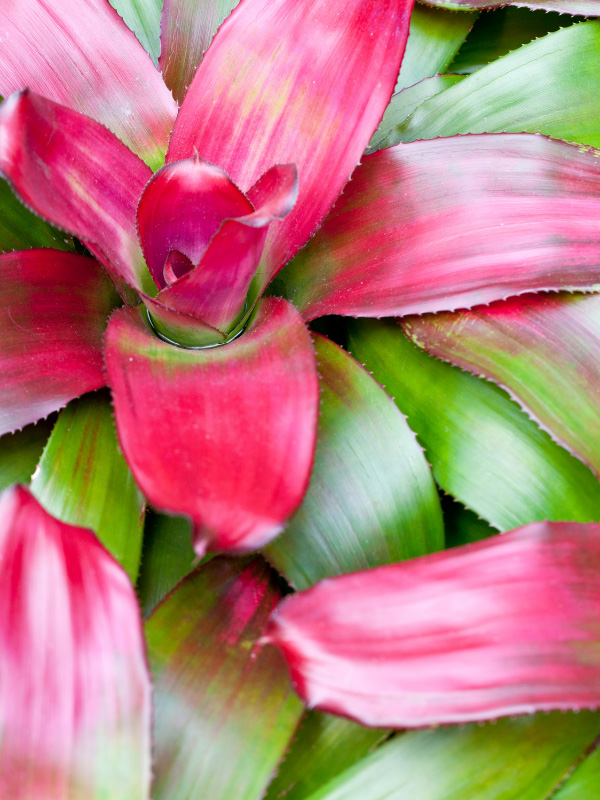
26. ZEBRA HAWORTHIA (Haworthia fasciata)
This beauty of a succulent is very easy to care for. Provide your Zebra Haworthia with plenty of light, including a few hours of direct sun per day indoors, water thoroughly, and allow your potting mix to dry out completely before watering again.

27. SWEDISH IVY (Plectranthus verticillatus)
This vigorous grower is a very satisfying houseplant to grow indoors. It grows quickly, is easy to care for, and very easy to propagate with cuttings in water.
It looks best in a hanging basket where the trailing branches can gracefully cascade. It also comes in a variegated version.

28. POLKA DOT PLANT (Hypoestes phyllostachya)
This native of Madagascar is a dainty houseplant with very colorful leaves. Avoid letting this plant completely dry out or you can quickly kill it if is left dry for too long.

29. Airplants (Tillandsia spp.)
Tillandsias, commonly called air plants, are part of the bromeliad family of plants. The species are native anywhere from southern United States, through Mexico, Central America and South America.
Most species are epiphytes and grow on tree branches. Check out my post on growing air plants. My personal favorite species is Tillandsia xerographica.

Although air plants are non-toxic, since they’re normally kept “loose” and don’t grow in a pot, take care to keep them out of reach from any pets that can still attempt to chew on the stiff, sometimes sharp leaves.
30. Jewel Orchid (Ludisia discolor)
This beautiful terrestrial orchid (growing in soil versus as an epiphyte like many other orchids), is a joy to grow. The foliage of this Jewel Orchid is stunning and it also easily blooms in the home. The foliage is the main focus though, as their flowers are insignificant compared to many other orchids.
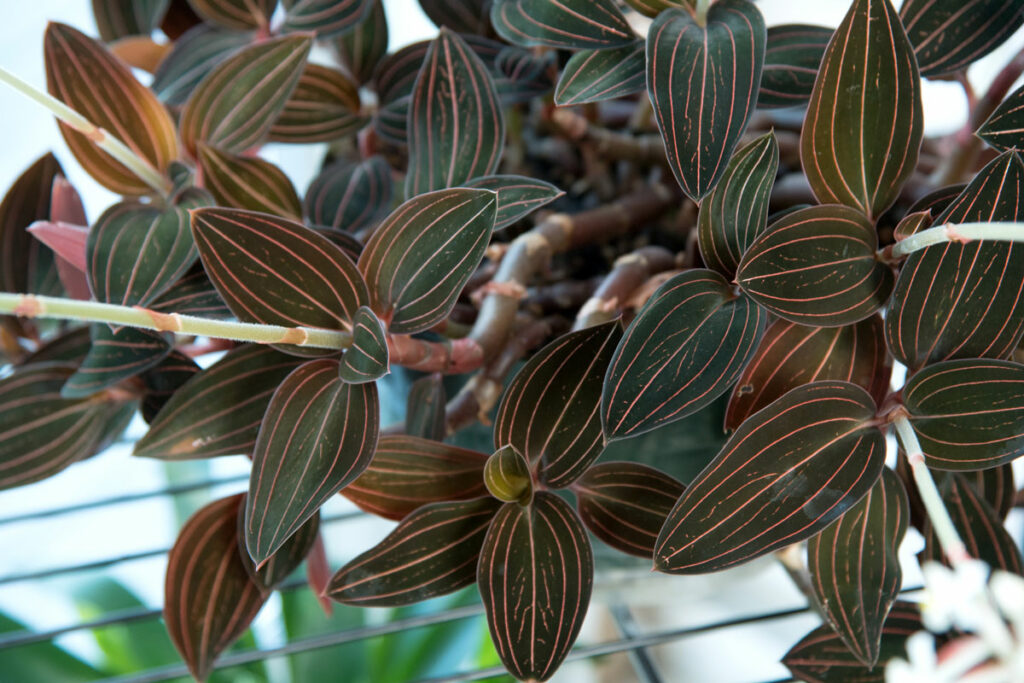
Although there are MANY houseplants that are considered toxic for pets, hopefully this list of nontoxic houseplants will ease your worries a bit, and perhaps the list of plants that you can grow is bigger than you initially thought!
If you are ever unsure if a plant is toxic or nontoxic, refer to the ASPCA website. You can also reference my post 40 Toxic Houseplants for Cats and Dogs.
Now…keeping your pets away from your plants is another story, but I’ll save that for a future post.


